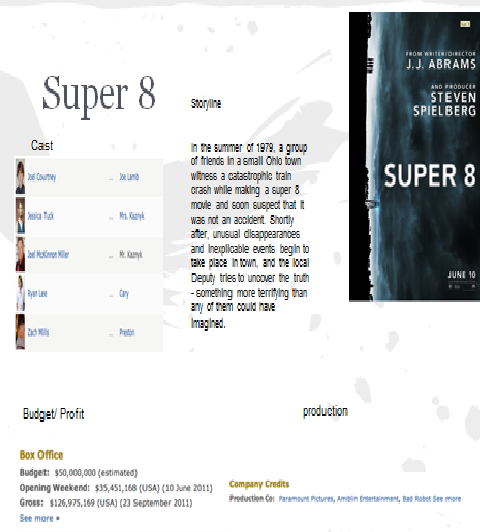00.00 - 00.01 = red carpet
00.01 - 00.06 = plate with food and 'fox searchlight pictures' written in sauce
00.07 - 00.07 = plate taken away
00.08 - 00.09 = white carpet
00.10 - 00.14 = plate with food and 'paramount pictures presents' written in sauce
00.14 - 00.15 = plate taken away
00.15 - 00.16 = blue carpet
00.16 - 00.21 = plate with food and 'in association with mtn films' written in sauce
00.21 - 00.22 = plate taken away
00.23 - 00.24 = shot of wallet
00.25 - 00.29 = shot of UFO abduction card, with 'starring Jon Heder' on it
00.30 - 00.36 = preston high school card
00.37 - 00.38 = green carpet
00.39 - 00.44 = plate of food with 'Jon Gries' written in sauce
00.44 - 00.45 = plate taken away
00.45 -00.46 = green carpet
00.47 - 00.48 = mustardy carpet
00.48 - 00.53 = plate of food with 'Aaron Ruell' written in sauce
00.54 - 00.55 = mustardy carpet
00.56 - 00.56 = green flooring
00.57 - 01.01 = tin of food with 'Efren Ramirez' written in sauce
01.01 - 01.02 = tin taken away
01.02 - 01.03 = green flooring
01.03 - 01.04 = mustardy flooring
01.04 - 01.08 = food with Tina Majorino
01.09 - 01.10 = mustardy flooring
01.10 - 01.11 = wooden flooring
01.12 - 01.15 = ninja star with 'with diedrich bader' written on it
01.16 - 01.16 = wooden flooring
01.17 - 01.17 = blue patterned carpet
01.18 - 01.19 = books placed on carpet
01.19 - 01.20 = book opened
01.20 - 01.26 = takes out library book return card, the card says 'casting by Jory Weitz'
01.26 - 01.27 = put card back
01.27 - 01.28 = open new book
01.29 - 01.34 = takes out library book return card, the card says 'music by John Swihart'
01.35 - 01.36 = put card back
01.36 - 01.37 = pushes books away
01.37 - 01.38 = carpet
01.38 - 01.42 = box of sweets placed on carpet, the box says 'Edited by Jeremy coon'
01.42 - 01.43 = box flicked away
01.43 - 01.45 = beige carpet
01.46 - 01.53 = lip balm with 'Production design by Cory Lorenzen'
01.53 - 01.54 = blue carpet
01.55 - 02.01 = drawing placed onto screen with 'Director of photography Munn Powell'
02.01 - 02.02 = blue carpet
02.02 - 02.03 = beige carpet
02.04 - 02.09 = drawing placed onto screen with 'Executive producer Jory Weitz'
02.10 - 02.11 = mustardy carpet
02.11 - 02.12 = stripey carpet
02.13 - 02.17 = 'produced by Jeremy Coon, Chris Wyatt, Sean Covel' appears on the screen
02.17 - 02.18 = stripey carpet
02.19 - 02.19 = laminate flooring
02.20 - 02.30 = pencils, rubber and protractor placed onto floor with 'Written by Jared Hess and Jekusha Hess' written on it
02.30 - 02.31 = pencils, rubber and protractor wiped away
02.32 - 02.33 = blue carpet 02.33 - 02.37 = plate of food placed down with 'Directed by Jared Hess' written with sauce on it
02.37 - 02.38 = burger bun out on top of burger
02.38 - 04.01 = black screen














